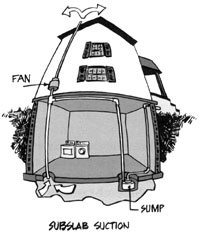What Is a Radon Mitigation System?
A radon mitigation system is any system or steps designed to reduce radon concentrations in the indoor air of a building.
Your house type will affect the kind of radon reduction system that will work best. Houses are generally categorized according to their foundation design. For example: basement, slab-on-grade (concrete poured at ground level), or crawl space (a shallow unfinished space under the first floor). Some houses have more than one foundation design feature. For instance, it is common to have a basement under part of the house and to have a slab-on-grade or crawl space under the rest of the house. In these situations a combination of radon reduction techniques may be needed to reduce radon levels to below 4 pCi/l.
There are several methods that a contractor can use to lower radon levels in your home. Some techniques prevent radon from entering your home while others reduce radon levels after it has entered. EPA generally recommends methods that prevent the entry of radon.
In many cases, simple systems using underground pipes and a radon system fan may be used to reduce radon. Such systems are called active soil depressurization, and do not require major changes to your home. These systems remove radon gas from below the concrete floor, or a membrane in a crawl space, and the foundation before it can enter the home. Radon contractors use other methods that may also work in your home. The right system depends on the design of your home and other factors.
Any information that you may have about the construction of your house could help your contractor choose the best system. Your contractor will perform a visual inspection of your house and design a system that is suitable. If this inspection fails to provide enough information, the contractor will need to perform diagnostic tests to help develop the best radon reduction system for your home. Whether diagnostic tests are needed is decided by details specific to your house, such as the foundation design, what kind of material is under your house, and by the contractor's experience with similar houses and similar radon test results.

Sub-slab depressurization is the most common and
usually the most reliable radon mitigation method.
In houses that have a basement or a slab-on-grade foundation, radon is usually reduced by one of four types of active soil depressurization: sub-slab depressurization, drain tile depressurization, sump hole depressurization, or block wall depressurization. Sub-slab depressurization is the most common and usually the best method for reducing radon. In this system, one or more suction pipes pass through the slab into the crushed rock or soil underneath. The pipes also may be put below the concrete slab from outside the house. A radon vent fan connected to the suction pipe draws the radon gas from below the house and releases it into the outdoor air. See the diagram for an example of a sub-slab depressurization system.
If your home has a crawlspace, the mitigation method will depend on the type of floor, how accessible it is, and whether the space is large enough to work in. If the crawlspace has a concrete floor, the preferred mitigation technique is sub-slab suction. If it has an earth floor, the preferred mitigation technique is sub-membrane suction. With sub-membrane depressurization, the floor is covered with a thick plastic sheet sealed to the crawlspace walls, foundation piers and any penetrations of the membrane. A radon system fan and piping system then draws the radon from under the membrane and vents it outdoors.
Homes with water control systems such as sump pumps, French drains, or an exterior loop of buried water-collection pipe can be effectively mitigated by connecting the active soil depressurization system to the existing water control system.
As part of installing a mitigation system, cracks and other openings in walls and floors in contact with the ground are sealed. Sealing does two things, it limits the flow of radon into your home and it reduces the loss of conditioned air, thereby making other radon reduction techniques more effective and cost-efficient. EPA does not recommend the use of sealing alone to reduce radon because, by itself, sealing has not been shown to lower radon levels significantly or consistently. Sealing cracks helps limit the flow of radon into a home, reduce the loss of heated or cooled/conditioned air, and make radon mitigation systems work better and cost less to operate over time. However, it is difficult to identify and permanently seal the places where radon is entering. Normal settling of your house opens new entry routes and reopens old ones.
Radon fans must be located in an unoccupied attic, a garage, or outside. The fan discharge is then routed up through the roof, or up along an outside wall, to a high point on the house. Although they must operate continually, operating costs of the fans are negligible due to their low power consumption (60 watts - less than most light bulbs - per fan).
A system indicator must be installed to warn the homeowner of any malfunctions.
Homes should be re-tested, but no sooner than 24 hours after a mitigation system has been operational.
Howe, S.
2019,
Radon Mitigation - What is a Radon Mitigation System?,
Extension | University of Nevada, Reno. IP


